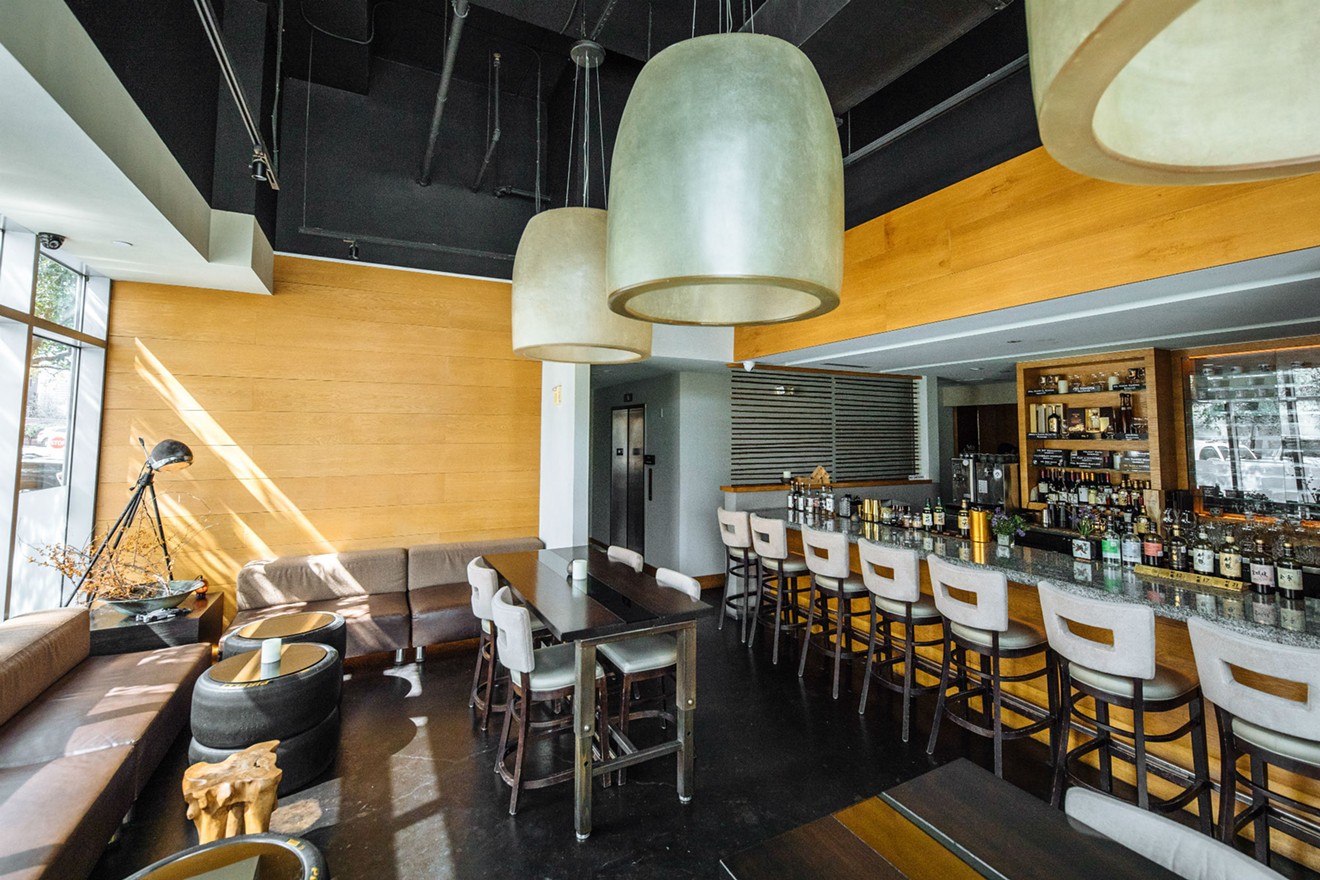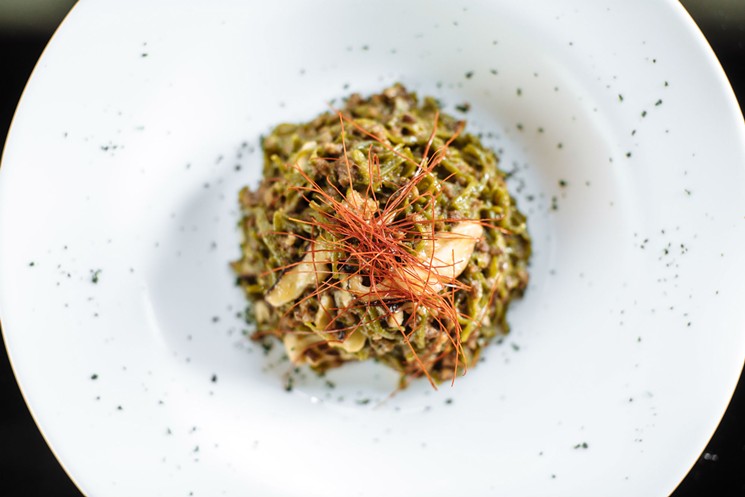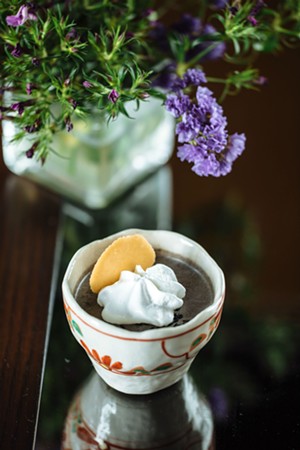What is it that makes Tei-An such a satisfying restaurant? The little things.
This is a place where every tiny detail deepens your gratification, adds to your respect. Tei-An is a restaurant where you can see that an owner and staff have thought carefully about every last moment.
The wooden chopsticks are the city’s most elegant, with a gentle, dark tone. Waiters extend black napkins to patrons in black clothing to, they explain, prevent any irritating lint. Then they might ask if you’re going to a show later in the evening, and when you might need to leave — and unlike at many restaurants, they will remember.
The staff members keep trained, confident eyes on the dining room; they may remove your empty plate or refill your water glass so discreetly you don’t even notice. Tasting menus are served with perfect timing: Each dish follows the last after you’ve had enough time to feel satisfied but not enough time to get impatient.
Even the imported Japanese toilets, with their gently warmed seats, are thoughtful.
Then there’s the care Tei-An puts into its food. Seven pieces of bonito sashimi, the fish flown in from Tokyo, aren’t served with wasabi ($21). Chef-owner Teiichi Sakurai prefers them with green onions, diced so finely you can’t help marveling at the knife skills on display. And the first bite of bonito — soft and savory, meaty like tuna but lighter, sunnier — validates the scallion decision.
One of the joys of Tei-An is that it can be as fancy or as unpretentious as you like. The sashimi is certainly exceptional, and rarities such as ankimo (monkfish liver) and jellyfish abound, but the menu also boasts a treasury of tavern foods done right. The seafood okonomiyaki ($16) is a pancake stuffed with fresh shrimp and fried to the crispness of a Michelin-starred bar snack. (Alas, the Michelin guide has not yet learned that Texas exists.) The tempura sampler features excellent technique applied to purple potato slices, shiitake and enoki mushrooms, shrimp and seasonally appropriate produce ($15).
Tei-An is a soba house at heart, making its noodles from scratch. They’re unusually delicate noodles, wire thin but able to absorb and retain flavors of sauces. The soba “Bolognese” ($24) is a Sakurai invention that has become a Dallas classic despite looking like it arrived from outer space. The noodles are green — they’re made with green tea — and the sauce riffs on the flavors of spaghetti Bolognese without having much in common with the Italian original. Finely diced shiitake mushrooms help supply meaty depth. It’s a delight.
And then there’s the fancy end of the spectrum. Tei-An recently began accepting reservations using Tock, an online system that treats meals like events, offering fixed-price tickets purchased in advance, tax and tip automatically added. Tock is not a pain or burden for customers to use — quite the opposite, unless you are a food critic who wishes to remain anonymous and must borrow a friend’s credit card to book your table. Indeed, Tock more clearly spells out some of Tei-An’s dining options, like the chef’s omakase tasting ($150), consisting entirely of what’s freshest and best that day, with a bowl of soba to finish. There is also a shorter four-course version ($80) for diners crunched for time.
The omakase menus allow you to choose whether you wish to experience the classics that made Tei-An one of the best restaurants in Dallas, or the inventions that continue to push the restaurant forward. The more basic options are essentially a greatest-hits parade, and a $150 chef’s tasting or a seasonal menu (when available) offers a deeper look at what Sakurai’s team is doing now. On one recent visit, the first course of the chef’s tasting was a bowl of raw, lightly dressed jellyfish.
The classics may be familiar, but they are timeless. The chef’s choice sashimi platter, a mainstay of the tasting menu, is an eye-popping platter of fresh fish, ranging from salmon ribbed with delicate stripes of fat to rainbow trout served with the skin still on. Katsuo, or skipjack tuna, is quickly seared and topped with another tangle of thinly diced scallions. Waiters call amaebi “sweet shrimp,” which might not prepare you for just how sweet its flesh will be. If shrimp heads appear on your sashimi platter, expect them to return later, fried.
The most lasting memories may still come at dessert. Tei-An's desserts get even better the more unlikely they sound, such as the improbable masterpiece black sesame mousse ($7). Black sesame seeds, also known as nigella seeds, are prized for their unique aroma, which conjures up memories of white sesame, thyme and fresh bread. But their flavor, in Tei-An’s dessert, is gently sweet with a nutty, almost peanut-buttery savory side that makes the mousse addicting. It’s the perfect dessert.
Few Dallas chefs have made as big a difference to the city’s dining scene as Sakurai. All of his restaurants have become Dallas favorites, and the two establishments he no longer owns are now under the care of the chefs he hired to lead them, Katsutoshi Sakamoto at Tei Tei Robata and Sakurai’s old boarding school classmate Masayuki Otaka at Teppo. Ten Ramen continues to gain statewide attention for its bowls of noodle soup.
But Tei-An is the flagship, and it is hard to imagine this city without this restaurant. As Dallas looks to assert itself on the national dining scene, the rest of the local fine-dining market should see Tei-An as a model of consistency, professionalism, perfectionism and, perhaps most important, confidence.
In a tempest of a restaurant labor market, Tei-An keeps customers feeling as though every detail is cared for. That’s almost as impressive as its food. Nobody here will interrupt your first bite of food to ask, “How is everything tasting so far?” There’s no need. They know.
Tei-An, 1722 Routh St., No. 110. 214-220-2828. Open for lunch 11:30 a.m. to 2 p.m. Tuesday through Friday, and for dinner 6-10:30 p.m. Tuesday through Thursday and 5:30-10:30 p.m. Friday and Saturday.
[
{
"name": "Air - MediumRectangle - Inline Content - Mobile Display Size",
"component": "18855504",
"insertPoint": "2",
"requiredCountToDisplay": "2"
},{
"name": "Editor Picks",
"component": "17105533",
"insertPoint": "4",
"requiredCountToDisplay": "1"
},{
"name": "Inline Links",
"component": "18349797",
"insertPoint": "8th",
"startingPoint": 8,
"requiredCountToDisplay": "7",
"maxInsertions": 25
},{
"name": "Air - MediumRectangle - Combo - Inline Content",
"component": "17105532",
"insertPoint": "8th",
"startingPoint": 8,
"requiredCountToDisplay": "7",
"maxInsertions": 25
},{
"name": "Inline Links",
"component": "18349797",
"insertPoint": "8th",
"startingPoint": 12,
"requiredCountToDisplay": "11",
"maxInsertions": 25
},{
"name": "Air - Leaderboard Tower - Combo - Inline Content",
"component": "17105535",
"insertPoint": "8th",
"startingPoint": 12,
"requiredCountToDisplay": "11",
"maxInsertions": 25
}
]

















